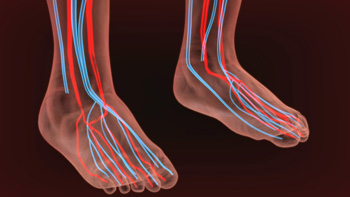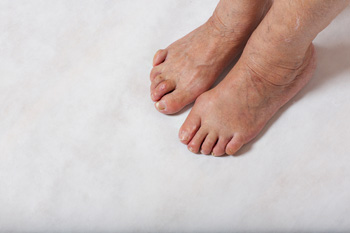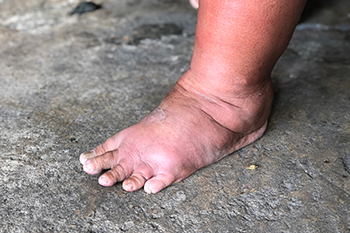Connect With Us
Blog
Items filtered by date: February 2025
Causes of Peripheral Vascular Disease

Peripheral vascular disease, or PVD, is a condition that affects blood flow to the limbs, particularly the feet and is often caused by narrowed or blocked arteries. In the feet, symptoms of PVD can include pain, cramping, numbness, or a cold sensation, especially during physical activity. The feet may also appear pale or have slow-healing wounds. Causes of PVD include atherosclerosis, smoking, diabetes, high blood pressure, and high cholesterol. Lifestyle changes play a significant role in managing PVD. Regular exercise can help improve poor circulation and reduce symptoms while quitting smoking can prevent further damage to blood vessels. A healthy diet low in saturated fats and rich in fruits, vegetables, and whole grains can help control cholesterol and blood pressure. Managing weight and reducing stress are also important in improving overall vascular health and preventing the progression of PVD. If you have symptoms of this disease, it is suggested that you are under the care of a podiatrist who can provide an accurate diagnosis and treatment.
Poor circulation is a serious condition and needs immediate medical attention. If you have any concerns with poor circulation in your feet contact one of our podiatrists of Florida Foot & Ankle Group, P.A.. Our doctors will treat your foot and ankle needs.
Poor Circulation in the Feet
Poor blood circulation in the feet and legs is can be caused by peripheral artery disease (PAD), which is the result of a buildup of plaque in the arteries.
Plaque buildup or atherosclerosis results from excess calcium and cholesterol in the bloodstream. This can restrict the amount of blood which can flow through the arteries. Poor blood circulation in the feet and legs are sometimes caused by inflammation in the blood vessels, known as vasculitis.
Causes
Lack of oxygen and oxygen from poor blood circulation restricts muscle growth and development. It can also cause:
- Muscle pain, stiffness, or weakness
- Numbness or cramping in the legs
- Skin discoloration
- Slower nail & hair growth
- Erectile dysfunction
Those who have diabetes or smoke are at greatest risk for poor circulation, as are those who are over 50. If you have poor circulation in the feet and legs it may be caused by PAD and is important to make changes to your lifestyle in order to reduce risk of getting a heart attack or stroke. Exercise and maintaining a healthy lifestyle will dramatically improve conditions.
As always, see a podiatrist as he or she will assist in finding a regimen that suits you. A podiatrist can also prescribe you any needed medication.
If you have any questions please feel free to contact one of our offices located in Debary, Lake Mary, Orlando, and Oviedo, FL . We offer the newest diagnostic and treatment technologies for all your foot and ankle needs.
Hammertoe and Why Women Are More at Risk

Hammertoe is a foot deformity where one or more toes bend abnormally at the middle joint, often leading to pain, stiffness, and difficulty wearing shoes. Older women are more likely to develop hammertoes due to years of wearing high heels, narrow-toed shoes, and unsupportive footwear that force the toes into unnatural positions. Over time, the muscles and tendons in the toes tighten, making the deformity permanent. Genetics, foot structure, and biomechanics also play a role, with women more prone to bunions and flat feet, both of which increase hammertoe risk. The condition often worsens with age, often leading to corns, calluses, and joint pain. Preventative measures include wearing roomier shoes with proper arch support and performing toe-stretching exercises. If you have a hammertoe and it becomes painful or rigid, it is suggested that you see a podiatrist for appropriate treatment.
Hammertoes can be a painful condition to live with. For more information, contact one of our podiatrists of Florida Foot & Ankle Group, P.A.. Our doctors will answer any of your foot- and ankle-related questions.
Hammertoe
Hammertoe is a foot deformity that occurs due to an imbalance in the muscles, tendons, or ligaments that normally hold the toe straight. It can be caused by the type of shoes you wear, your foot structure, trauma, and certain disease processes.
Symptoms
- Painful and/or difficult toe movement
- Swelling
- Joint stiffness
- Calluses/Corns
- Physical deformity
Risk Factors
- Age – The risk of hammertoe increases with age
- Sex – Women are more likely to have hammertoe compared to men
- Toe Length – You are more likely to develop hammertoe if your second toe is longer than your big toe
- Certain Diseases – Arthritis and diabetes may make you more likely to develop hammertoe
Treatment
If you have hammertoe, you should change into a more comfortable shoe that provides enough room for your toes. Exercises such as picking up marbles may strengthen and stretch your toe muscles. Nevertheless, it is important to seek assistance from a podiatrist in order to determine the severity of your hammertoe and see which treatment option will work best for you.
If you have any questions, please feel free to contact one of our offices located in Debary, Lake Mary, Orlando, and Oviedo, FL . We offer the newest diagnostic and treatment technologies for all your foot care needs.
Causes and Relief for Swollen Feet and Ankles

Swelling in the feet and ankles, known as edema, can result from various causes, ranging from minor issues to more serious medical conditions. Common causes include prolonged standing, high-sodium diets, pregnancy, and injuries like sprains. Medical conditions such as venous insufficiency, heart or kidney problems, and lymphedema can also lead to fluid buildup in the lower extremities. Treatments depend on the underlying cause. Simple remedies include elevating the legs, wearing compression socks, and reducing salt intake to minimize fluid retention. Gentle stretching and exercise can help improve circulation. Persistent or worsening swelling may require medication or targeted therapies. If you have chronic or unexplained swelling in your feet or ankles, it is strongly suggested that you consult a podiatrist to identify the cause and receive appropriate care.
Swollen feet can be a sign of an underlying condition. If you have any concerns, contact one of our podiatrists of Florida Foot & Ankle Group, P.A.. Our doctors can provide the care you need to keep you pain-free and on your feet.
Swollen feet are a common ailment among pregnant women and people who stand or sit for extended periods. Aging may increase the possibility of swollen feet and patients who are obese often notice when their feet are swelling too. There may be medical reasons why swollen feet occur:
- Phlebitis - A condition that causes the veins to become inflamed and can also cause leg pain.
- Liver disease - This may lead to low blood levels of albumin which is a protein. This can cause fluid in the blood to pass into the tissues and several areas of the body can become swollen.
- Heart failure - When the heart doesn’t pump properly the blood that is normally pumped back to the heart can pool in the veins of the legs causing swollen feet.
- Kidney disease - One of the main functions of the kidneys is releasing excess fluid in the body. This type of condition can make it difficult for the kidneys to function properly, and as a result the feet may become swollen.
- Deep-vein thrombosis (DVT)- This is a serious condition where blood clots form in the veins of the legs. They can block the return of blood from the legs to the heart which may cause the feet to swell. It is important to be treated by a podiatrist if this condition is present.
Swollen feet can also be caused by bone and tendon conditions, including fractures, arthritis, and tendinitis. Additionally, there may be skin and toenail conditions and an infection may cause the feet to swell. Patients who take medicine to treat high blood pressure may be prone to getting swollen feet.
Many patients elevate their feet to help relieve the swelling and this is generally a temporary remedy. When a podiatrist is consulted the reason behind the swelling can be uncovered and subsequently treated.
If you have any questions please feel free to contact one of our offices located in Debary, Lake Mary, Orlando, and Oviedo, FL . We offer the newest diagnostic tools and technology to treat your foot and ankle needs.
Wounds That Don't Heal Need to Be Checked
Blog Archives
- April 2025
- March 2025
- February 2025
- January 2025
- December 2024
- November 2024
- October 2024
- September 2024
- August 2024
- July 2024
- June 2024
- May 2024
- April 2024
- March 2024
- February 2024
- January 2024
- December 2023
- September 2023
- August 2023
- June 2023
- May 2023
- April 2023
- March 2023
- February 2023
- January 2023
- December 2022
- November 2022
- October 2022
- September 2022
- August 2022
- July 2022
- June 2022
- April 2022
- March 2022
- February 2022
- January 2022
- December 2021
- October 2021
- September 2021
- August 2021
- July 2021
- June 2021
- May 2021
- April 2021
- March 2021
- February 2021
- January 2021
- December 2020
- November 2020
- October 2020
- September 2020
- August 2020
- July 2020
- June 2020
- May 2020
- April 2020
- March 2020
- February 2020
- January 2020
- December 2019
- November 2019
- October 2019
- September 2019
- August 2019
- July 2019
- June 2019
- May 2019
- April 2019
- March 2019
- February 2019
- January 2019
- December 2018
- November 2018
- October 2018
- September 2018
- August 2018
- July 2018
- June 2018
- May 2018
- April 2018
- March 2018
- February 2018
- January 2018

